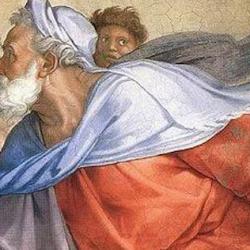Theopolis student Jacob Hanby pointed out that Ezekiel uses the phrase “the hand of Yahweh” seven times. It appears at major junctures in the prophecy:
Ezekiel 1:3: The first verses of Ezekiel provide a double narrative opening (first person, then third person) to a prophecy that is largely taken up with direct quotations from Yahweh or descriptions of divisions. When the word of Yahweh comes to Ezekiel by the river Chebar, then “the hand of Yahweh came upon me.” Word and hand lead Ezekiel to see visions of God.
Ezekiel 3:14, 22: The first chapters of Ezekiel are a long narrative of the prophet’s call. Yahweh appears in glory, and gives Ezekiel a book to eat. After he has eaten, the Spirit lifts lifts him (3:12, 14) so that he is filled with rage. At that point, “the hand of Yahweh was strong on me” (3:14). After seven days, Yahweh appoints him as a watchman over Israel (3:16-21) and then takes him to a plain where he again sees Yahweh’s glory and learns that he will be dumb before the people – a dumb spokesman! Yahweh’s hand is on Ezekiel as he is taken to the vision on the plain (3:22).
Ezekiel 8:1: In the sixth year (since his call? of his silence?), Ezekiel is sitting among the elders when the hand of Yahweh “falls” on him. A fiery man takes him by a lock of hair and carries him by the Spirit to the entrance of the north gate of the temple. This begins a sequence of explorations of the abominations in the temple, and a vision of Yahweh’s departure from His house.
Between chapter 8 and 33, Ezekiel does not use the phrase “the hand of Yahweh.” Yahweh speaks several times of His hand, usually referring to His hand of discipline and judgment, against both Israel and Gentiles (13:9; 14:9, 13; 16:27; 20:33; 25:13, 16). After chapter 33, He also refers to “My hand” (35:3; 37:19). But after 8:1, the next occurrence of the exact phrase “the hand of Yahweh” is in 33:22.
Ezekiel 33:22: At the beginning of his prophetic ministry, Ezekiel has been rendered speechless (like Zechariah in Luke 2, after his vision of an angel; suss out the parallels at your leisure). After a long series of oracles against the nations, news reaches the exiles that Jerusalem has fallen (33:21) and the hand of Yahweh comes on Ezekiel to open his mouth (33:22). The hand of Yahweh closes, the hand of Yahweh opens; blessed be the hand of Yahweh.
Ezekiel 37:1: Again the hand of Yahweh is a means of transport, coming on Ezekiel in order to carry him to a valley full of bones. There, of course, he prophesies until the bones assemble, take flesh, and then come alive by the breath of Yahweh. The Spirit of Yahweh makes another appearance (37:1), again transporting the prophet, the first time he has done so since 11:24, the conclusion of the vision that began in chapter 8.
Ezekiel 40:1: Fourteen years after Jerusalem fell to Babylon, Yahweh’s hand comes upon Ezekiel and takes him to the city, where he sees an extended vision of the renewed temple, city, and land (chs. 40-48).
The hand of Yahweh is there at the beginning of the book, at Ezekiel’s call, at the beginning of his temple vision, when the Lord loosens his tongue, when he sees the vision of a risen Israel, and when he is shown the future house of Yahweh. There are of course other subdivisions in the book, but the phrase occurs at important junctures with deliberate regularity.
There’s a neat 4 + 3 pattern. The first four references come in a context where the message is primarily one of judgment. The hand of Yahweh imposes silence and shows Ezekiel the evils perpetuated by the priesthood. The final three uses mark positive turning points – Ezekiel speaks, Ezekiel sees Israel rise from the grave, Ezekiel sees visions of Israel’s glorious future.
And, did I mention the phrase is used seven times? Seven . . . seven. Where have I heard that before?
Some of the visions parallel the days of creation. The sixth hand-of-Yahweh vision (Ezekiel 37) reenacts the creation of man, taken from the dust and animated by the breath of God. Ezekiel 40-48 is a vision of a land at rest, where Yahweh is enthroned as king; it is a Sabbatical vision.
Do the other hand-of-Yahweh sections match the days of creation? Not in any obvious way. 1:3 might be an “in the beginning” episode. Perhaps the vision on the plain in that begins in 3:33 links with the emergence of dry land on Day 3. Ezekiel is among the elders – the starry rulers of Judah – when the hand comes on him the fourth time (8:1). All that is pretty thin. The connections might be stronger if we took the time to overlay the creation week with “seven day” sequences from Genesis 2 or Exodus 25-31.
Still, the number itself hints at a new-creation structure to the book, especially since the final visions make such a neat match with Days 6 and 7. The hand of Yahweh comes on the prophet so that he can speak a sevenfold word that remakes Judah and the world around her.












